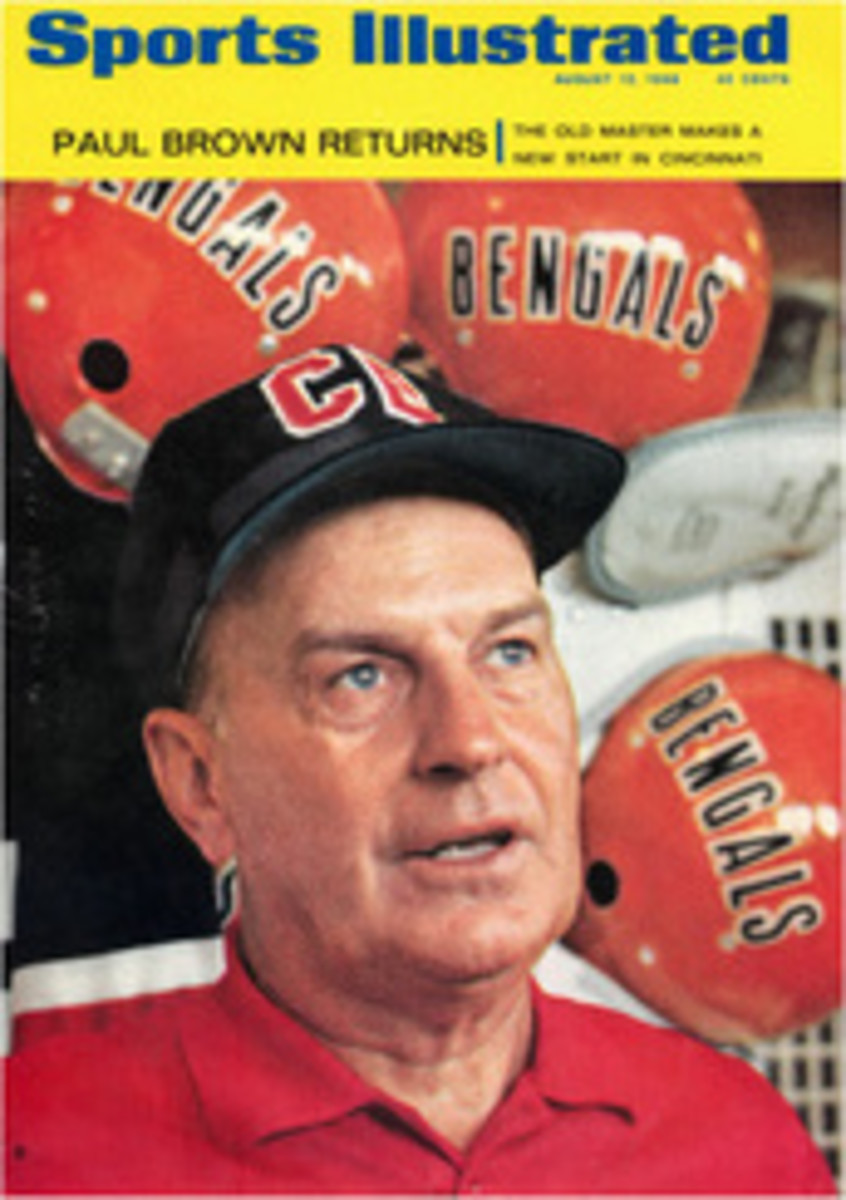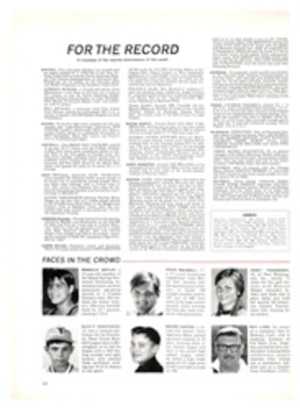
THE LONER LEADS THE CHARGE
The thing about Lee Roy Yarbrough is that he has always had this uncanny knack for finding trouble. His childhood, spent in Jacksonville as one of six children, was filled with loneliness and bad feelings that he won't discuss even today. "A lot of things happened to me," he says, "and there are a lot of things I just don't want to remember." He has described himself as a juvenile delinquent of those days. On the racetrack as an adult, it was no better.
Nearly every good Southern stock-car driver, as most fans know, comes from the red-clay region of what is called the Piedmont Plateau, an area stretching from Fort Royal, Va. in the north to Columbus, Ga. in the south. All you need is a bulldozer to turn a nice oval in the clay and some branch water, and you can go racing. But west of that is the Blue Ridge, and south—around areas like Jacksonville—is the Central Plain, where the only thing you scrape up with a dozer is sand and rocks and swampland. And drivers are different. The outlaw tracks there are the meanest of a mean lot and even the chargers from the Piedmont say you have to be crazy to race on a rutted, bog-holed track in the Plain. That was where Lee Roy started.
Even when he moved north, to Columbia, S.C. in the early '60s, it was hard to unlearn the racing lessons. His reputation grew, with his talent, as a hard-nosed loner in a business already filled with loners.
Driver Tiny Lund was only half-smiling when he said, "Lee Roy is the only real bad ass left among the top drivers. Everybody is individual, but he is really different from the rest. He has always been real mean out on the track, and he keeps to himself all the time."
But Lee Roy was good and always had a future, and none other than the late Fireball Roberts thought so, too. In one of his last radio appearances before he was fatally burned in Charlotte in May 1964, Fireball said flatly that he reckoned Lee Roy Yarbrough was going to be the next great stock-car driver.
When Lee Roy finally slows down long enough to take a good look at his scrap-book he may well remember that things finally turned for him when he wheeled his 1968 Mercury Cyclone into victory lane last Sunday, the winner of the Dixie 500 at the Atlanta International Raceway. He was $17,390 richer, boosting his season total to nearly $75,000—close to what his lifetime earnings were going into this season.
The Dixie 500, Atlanta's last race of the year, is always a bit special, mainly because it has proved so difficult to win. In the nine years the race has been run there have been nine different winners. There are a lot of reasons, but in essence it comes down to the track, an undulating 1½-mile oval filled with all sorts of waves and bumps that keep a car going sideways about as much as it goes forward. Then there is the heat—when the green flag dropped Sunday, the track temperature was 141°—which causes the asphalt to "bleed," or spread oil in a thin, ice-slick coating. Finally, the straights at Atlanta are only a quarter-mile long, which means that a driver spends nearly all of his time entering, in the middle of or leaving a turn. It is not a pleasant way to spend a Sunday.
There was the usual quality field for the seventh NASCAR superspeedway race of the year, with one extra added attraction. The three drivers who have most recently gained their reputations as all-out chargers were starting in the first two rows, piston to piston, for the first time in their careers. On the pole was Buddy Baker, a youthful giant of a man. On the outside pole was NASCAR's leading money-winner this season and its most successful big-track driver, Cale Yarborough. On the outside of the second row sat Lee Roy.
Baker was the first to fall. This was not really surprising because, despite being the fastest qualifier, his whole week had been something of a disaster. First off, he bumped his head getting out of his car after a practice session, not difficult since he stands 6'5". Then he couldn't get the car to handle properly and spent most of the week flailing away at the steering wheel as if it wasn't attached to anything, while his Dodge Charger sort of went its own way around the track. If that was not enough, the night before the race Baker dived into his hotel swimming pool—unfortunately the shallow end—and showed up on race day with a bruise over his right eye and a wicked bump on the back of his neck.
"Had anybody look at that?" he was asked.
"Nope," he grimaced. "Not today. I'm afraid they might find something and keep me out of the race." Baker promptly outdragged Cale to the first turn, but lost the lead on the back-straight of the same lap and quickly fell back to sixth place. Then, on his first pit stop, a crew member cross-threaded a lug nut while changing a tire, which cost him four laps. He eventually drove behind the wall and parked it. Just beyond the halfway mark Cale Yarborough pitted several times in quick order to replace a burned-out wheel bearing in his Mercury, thus falling far behind the pack. Then he whomped the guardrail in the No. 2 turn several laps later—and he, too, retired.
Chrysler Corp., meanwhile, was taking its motorized shots at Lee Roy and failing everywhere. Charlie Glotzbach, in a Dodge, actually threatened to run away with the whole race in the early wheeling and only a succession of caution flags (there were 11 in all) kept the field closely bunched. But Glotzbach, who has not spent a lot of time on the superspeedways, was apparently overextending his car and, more importantly, his tires. It was hot going and the rubber was heating to temperatures somewhere beyond 270°. Glotzbach lost his right rear tire in the No. 4 turn, got it fixed, then just 11 laps later the right front chunked—sending pieces of rubber bouncing down the main straight and putting Glotzbach out of the race.
That left Richard Petty in a Plymouth and David Pearson in a Ford as the prime challengers.
You remember Richard Petty, tall, curly-headed, most successful stock-car driver of all time in 1967. He ran up a record 27 victories, three of them on major tracks, and won $130,275. But this year all of his 10 wins have been on the short tracks. So with 60 miles left, Petty, Pearson and Ford's Donnie Allison ran over debris practically on the same lap which chewed their tires up, and cost them time in the pits.
By then Lee Roy was home free. Still, one always wonders. After all, it was Lee Roy who was blinded when a foam fire extinguisher went off in his car during a practice session at Charlotte last year. He was nearly suffocated; the car careened into the wall and bounced back on the track in three separate and distinct pieces.
Then this year, Lee Roy's first as a driver for car owner Junior Johnson—the circuit's No. 1 hellion in his own day—all sorts of untoward things happened. In fact, Lee Roy was quickly getting the reputation as "the other Yarborough—the one without the first O"—because he had finished second to Cale in three major races this year, twice under peculiar circumstances (his only victory of the year was at Trenton, N.J. four weeks ago when Cale took the week off).
In the Daytona 500 Lee Roy was leading with less than 20 laps to go when he suddenly pitted, for no apparent reason. There was one. Junior's crew had flashed him a sign that read "P-1," which, to Junior, meant that Lee Roy was in first place. Lee Roy had other ideas. He thought it meant to pit—in one lap. Cale won that race by one second. For the rest of the year Lee Roy has had the pit signals pasted handily to his dashboard.
Then at the Atlanta 500 Lee Roy was penalized one lap for jumping the pace car under the caution flag. Lee Roy and Junior claimed that Cale did it, too, and should also have been penalized. Cale wasn't—and also won that race.
But strangely enough, nothing like that happened in Sunday's last laps, and Lee Roy had his first major victory since 1966 and his first in the year he had been driving for Junior.
After the race Lee Roy held court with Junior Johnson and Chief Mechanic Herb Nab at his side, and the inevitable question was asked: When did you think you had it won?
"When the checkered flag fell," he answered grimly.
It was a cornball answer to a corn-ball question; but then, considering Lee Roy, maybe it wasn't.
PHOTO
Mercury's cyclone, Lee Roy Yarbrough in car 98, wheels around ahead of the pack to capture the Dixie 500 in Atlanta and a $17,390 payday.
PHOTO
Lee Roy knew when he saw the flag.

